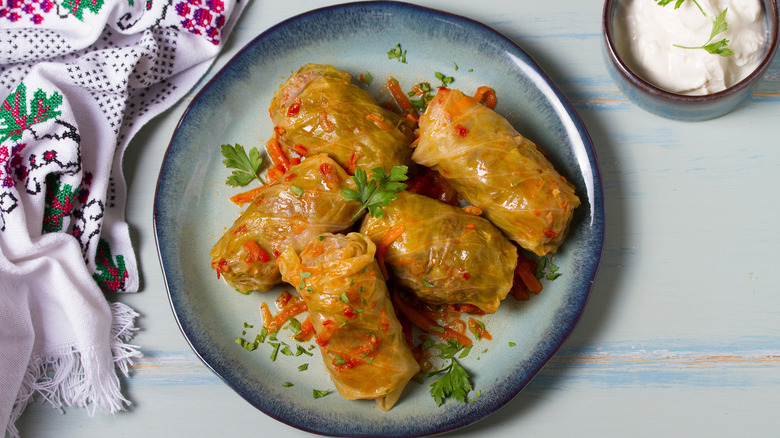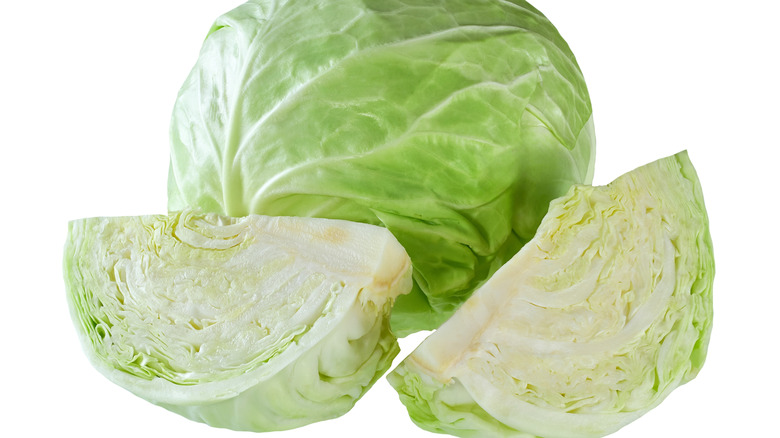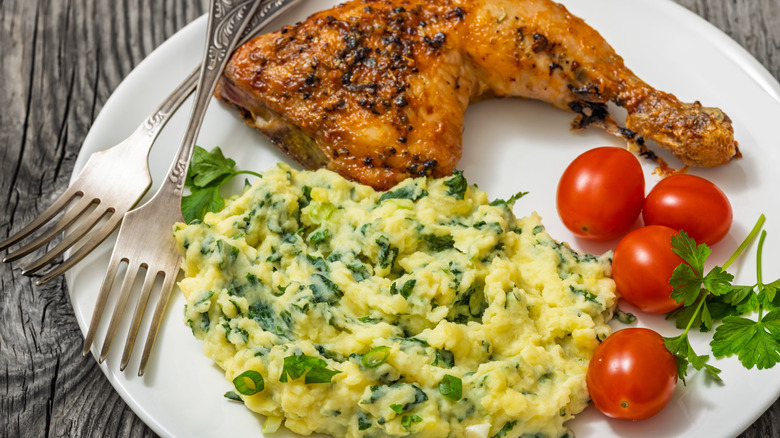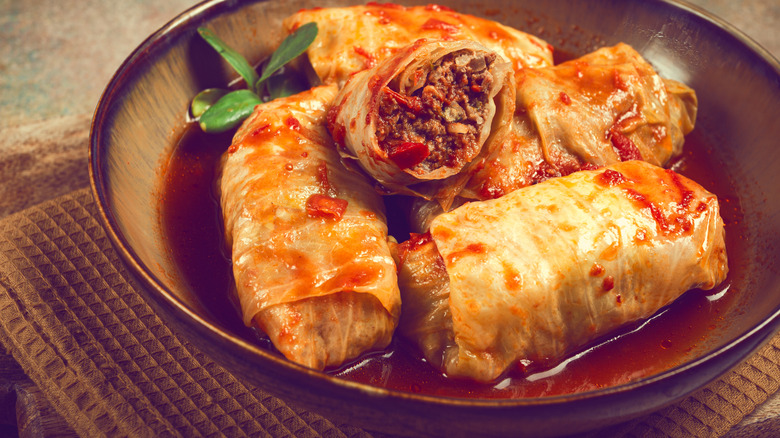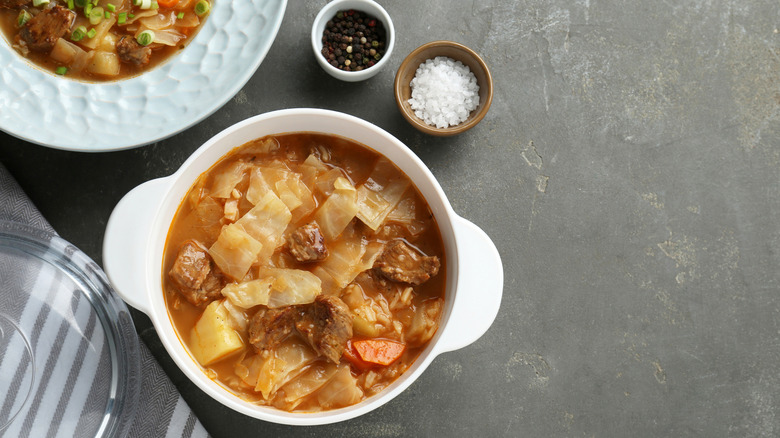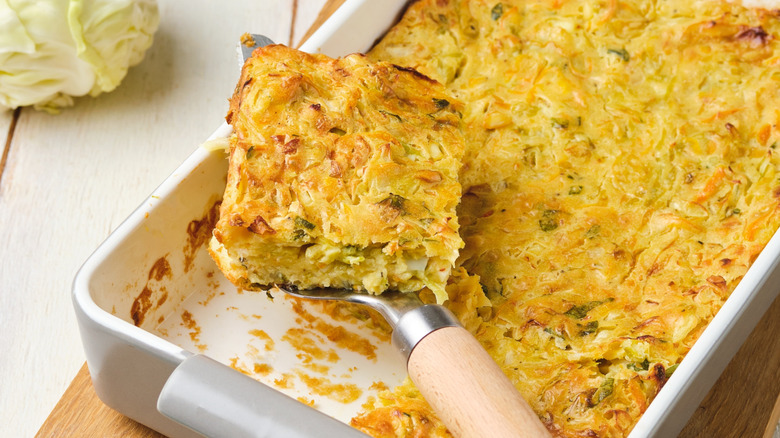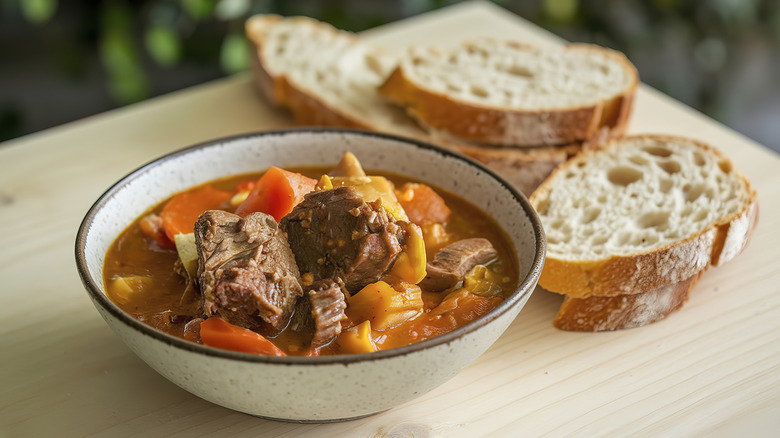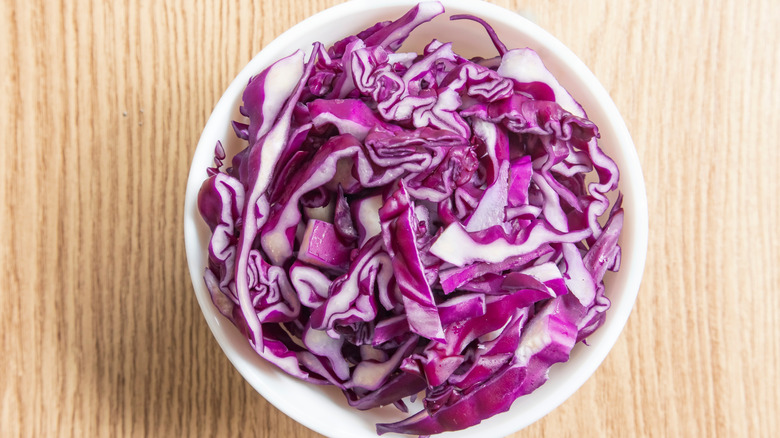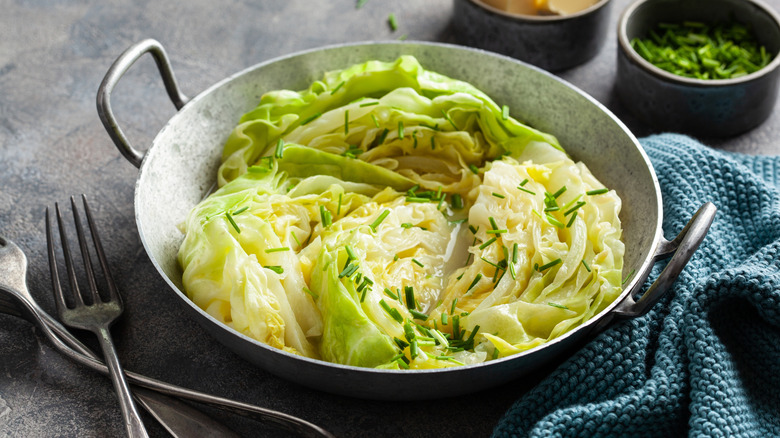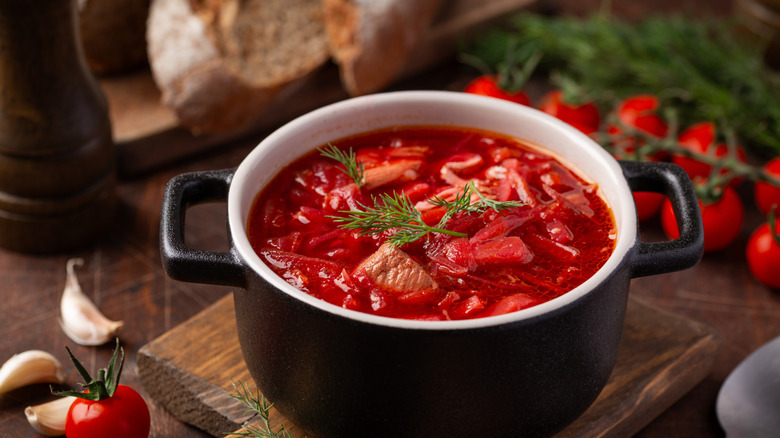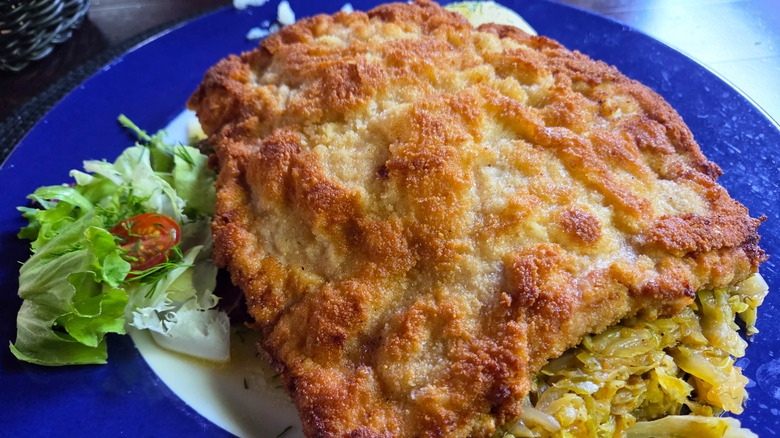Old-School Cabbage Dishes No One Really Makes Anymore
Cabbage isn't exactly crave-worthy, but when prepared correctly, it can be downright delicious. Not only is this cruciferous vegetable typically budget-friendly, but it's also packed with nutrients, and contains plenty of the vitamins K and C. Unlike some hard-to-find produce that you can only buy at your grocery store seasonally, you'll have no problem finding cabbage all year long. These days, the vegetable is getting a creative twist, replacing meat as thick and hearty cabbage steaks, and even standing in for pasta for those on low-carb and keto diets.
Years ago, however, cabbage turned up more often in recipes, either complementing meat in dishes such as beef stew, accompanying other types of vegetables, or standing alone in refreshingly sour salads. Not only did they add flavor to the recipes, but they also provided texture, nutrition — and in the case of red cabbage, a vibrant pop of color, too.
While some of these old-school cabbage dishes are still being served at home and even in restaurants, especially international eateries, many have fallen in popularity over the years. Try out one or more of these comforting cabbage recipes in your kitchen, and bring back a bit of vintage flavor.
Cabbage pottage
Cabbage pottage is a simple yet tasty dish dating back to the 14th century, when the recipe was featured in the "Fourme of Cury," an ancient English cookery book which was made for King Richard II of England. This compilation of winter vegetables, including green cabbage, is thought to have been prepared by peasant farmers as "famine food" when sustenance was scarce. With the addition of rare and expensive spices such as saffron, cabbage pottage found its way to kings' tables and in the households of other nobles. Another element that made the dish fit for a king was the fact that cabbage wasn't widely available in England at the time, which gave it an even more elite quality.
Today, you won't find cabbage pottage on many restaurant menus, except in Hungary, where the dish is known as főzelék, a hearty potato and cabbage stew. If you want to try your hand at making this Medieval recipe, start by cutting one large head of green cabbage into quarters. Slice two leeks and a large onion, and add them to a pot along with the quartered cabbage. Pour beef broth over the vegetables, and season to taste. Bring the broth to a boil, and then reduce to a simmer. Cover the pot and cook the vegetables until they're tender. You can enjoy the cabbage pottage as a vegetarian meal on its own, or alongside meat, such as deliciously salty corned beef.
Colcannon
Colcannon, a combination of fried onions, cabbage, and mashed potatoes, is a traditional Irish recipe. The dish bursts with flavor and a variety of textures from the sweet and tender shredded cabbage, rich and creamy potatoes, and a bit of heat from the onions. The term "colcannon" comes from "cal ceannann," the Irish word for white cabbage.
While the cabbage contributes a distinctive flavor to the dish, the secret to perfect colcannon also lies in the potatoes. Traditionally, the recipe calls for starchy potatoes, such as the Blue Congo, King Edward, and Maris Piper varieties, which are super fluffy when mashed. If you don't have access to any of those types of spuds, russets will work as well. To create an authentic Irish meal, serve the colcannon with corned beef or lamb chops.
Although colcannon is no longer a common dish in most parts of the world, you can easily bring a bit of traditional Irish flavor to your table by whipping up a batch yourself. Start by boiling potatoes in a saucepan until they are tender when pierced with a fork, and then drain them. Next, mash the potatoes using your favorite technique, and fry chopped white onions and white cabbage in a pan until soft. Combine the cabbage mixture with the mashed potatoes, and blend well. Finish the dish with salt and pepper to taste, and plenty of butter. You can use leftover colcannon to make shepherd's pie or cottage pie, or potato pancakes, the next day.
Cabbage rolls
Cabbage rolls, also sometimes known as stuffed cabbage, is an old-school dish that tastes just as good today as it did decades ago. Although there are several different ways to prepare the rolls, the traditional recipe calls for green cabbage leaves, ground meat, and a tangy tomato-based sauce.
When it comes to the meat, you can use any type you'd like, such as ground beef, sausage, turkey, or even a combination of a few different kinds. The addition of cooked rice and egg works to keep the filling together once it's wrapped in the cabbage. You can also experiment with a vegetarian version of cabbage rolls, substituting soy-based protein. While cabbage rolls are a one-pot meal, they're traditionally served with a side of sauerkraut or mashed potatoes.
To make the rolls, start by cooking white rice, and then add it to a bowl of ground meat along with a good brand of Worcestershire sauce, egg, and seasonings such as salt, pepper, onion and garlic powder, and parsley. Boil a head of green cabbage in a pot until it's tender, then allow it to cool. Carefully peel the leaves off, making sure they don't tear. Place a bit of the ground meat mixture into each leaf, and roll it up tightly. You can secure the roll with toothpicks. Place the rolls seam-side down in a baking dish and cover with tomato sauce. Cover the dish tightly with foil, and bake until the rolls are cooked through.
Sauerbraten soup
Sauerbraten soup or stew is a handy way to use leftover sauerbraten, a traditional German dish featuring marinated beef roast that is sliced and served with a brown gravy. Since the meat is marinated for days in a red wine vinegar-based marinade, it suits tougher cuts of beef such as chuck roast – the best cut of meat to use for pot roast. Both the meat and gravy can be transformed in a rich and savory soup, which makes the beef even more tender. A mixture of shredded sweet-and-sour red cabbage and other ingredients, such as seasonings and onions, are added to make the dish even more flavorful.
This old-fashioned recipe has an unusual twist that may surprise you, but is essential to achieving the authentic flavor and texture: gingersnap cookies. They help thicken the soup while infusing it with a spicy-sweet pop of flavor.
To make this vintage soup, sauté chopped carrots, celery, and onions, along with shredded cabbage, in melted butter in a large saucepan. Cook the vegetables until they're softened, and then pour in beef stock or broth. Add cubed potatoes, bay leaf, thyme, and simmer the mixture until the potatoes are tender. Finally, cut the leftover sauerbraten beef up into bite-sized pieces, and stir it into the pan. Add crushed gingersnap cookies, and simmer the soup until all of the flavors are combined. You can also add cooked egg noodles to the soup right before serving.
Pickled cabbage
Although it sounds simple, pickled cabbage is a delicious and flavorful side dish that has withstood the test of time. Sour with a slight natural sweetness from the cabbage, this recipe just takes a few minutes to make but will last for up to a few weeks when stored in an airtight jar in your refrigerator.
This old-school dish is convenient and versatile in that you can use either green or red cabbage to make it, and it's easily customizable. Traditional pickled cabbage recipes call for a basic combination of distilled white vinegar, water, and just salt and pepper to taste, but you can play around with ingredients to make the dish your own. Put a spin on the classic cabbage recipe with the addition of Cajun seasonings, or go for an Asian flair with ginger and red chili peppers.
If you want to make a batch of classic pickled cabbage, start by finely shredding a head of either red or green cabbage with a mandolin or a sharp knife. Pack the shredded cabbage into a glass jar and cover it with a vinegar, water, sugar, and salt brine. Some old-school recipes also include seasonings such as cumin, whole black peppercorns, and caraway and mustard seeds. Place a tight lid on the jar, and chill the shredded cabbage in your refrigerator for at least an hour before serving for the best flavor. Serve the pickled cabbage on sandwiches and hamburgers, in grain bowls, or on tacos.
Cabbage casserole
Warm and comforting, cabbage casserole was a popular dish at potlucks, on holiday buffet spreads, and even weeknight dinner tables in the past. Although it may not be as popular as green bean or chicken and rice casseroles these days, it's tasty — and affordable — enough to bring back into rotation.
Another positive aspect of classic cabbage casserole is that you most likely have everything you need to make it on hand. The ingredients in this creamy old-fashioned casserole blend perfectly, allowing the cabbage's natural sweetness and crunchy texture to shine. This classic casserole is hearty enough to serve as a main course, or works well alongside any type of meat dish.
Treat your dinner party guests to this tasty blast from the past by chopping a head of green cabbage into bite-sized pieces, making sure to remove the core first. In a large bowl, combine the chopped cabbage with diced onions, fresh parsley, and shredded cheddar cheese, and transfer the mixture to a greased casserole dish. In a saucepan, combine heavy cream, butter, vegetable broth, and seasonings to taste, and simmer on low heat until it's foamy. Pour the creamy sauce over the cabbage mixture, and top with crushed butter crackers and more shredded cheese. Bake the casserole for about 45 minutes, or until it's golden brown and bubbling.
Beef and cabbage stew
Another warm and comforting dish that you don't hear of much anymore is beef and cabbage stew. It makes a hearty dinner anytime of the year, but is especially satisfying on cold nights. Cabbage soup, or cabochis, dates back to the 15th century, during England's Medieval days, but over time, beef and other veggies were added to the mix. Beef and cabbage stew is an economical meal option when cabbage is in season, and the liquid will help tenderize cheaper, tougher cuts of meat such as brisket.
The traditional beef and cabbage stew recipe calls for broth and canned tomato sauce, but adding V8 juice to the beef stew will make it taste even better. It will also enhance the stew with an extra shot of nutrition, since the juice is made with a total of eight vegetables.
Make a batch of this hearty comfort food in your slow cooker by first browning the meat of your choice, along with diced onions and celery, in butter. Transfer the mixture to your slow cooker, along with chopped green cabbage and white or red potatoes. Add the beef broth, tomato sauce, or V8 juice, and water. Season with salt, pepper, and any other desired spices. Cook the stew on low for six to seven hours, or until the meat and vegetables are tender. Enjoy with crackers or some crusty bread.
Sweet and sour red cabbage
Not only does sweet and sour cabbage, which is traditionally made with the purple variety, taste delicious, it also makes a visually pleasing side dish. The recipe only calls for four basic ingredients that you probably already have in your pantry and refrigerator, but it can make a big impact on your dinner table.
This traditional German dish was often served on holiday food spreads, and can be customized to your palate. For instance, if you want to kick the basic recipe up a few notches, don't be afraid to add some chopped apples or roasted chestnuts to the dish, especially if you're serving it during the fall months. This sweet and tangy concoction can replace sauerkraut when served with pork chops or roast, schnitzel, and even chicken.
To prepare this vintage dish, thinly slice red cabbage using a mandolin or a sharp knife after removing its core. Saute the cabbage in butter until the vegetable is slightly wilted, which will take about five minutes. Add balsamic vinegar and sugar and mix well. Cover the pot and simmer the cabbage for 30 to 45 minutes, or until it's tender. Finish by seasoning it with salt and pepper to taste.
Stewed cabbage
Stewing green cabbage is a fast and easy way to enhance the humble cruciferous vegetable's flavor, making it holiday table-worthy. Also sometimes referred to as buttered cabbage, stewed cabbage is a classic Southern dish consisting of just a few ingredients.
Throughout the years, this hearty and delicious recipe has been a staple during cabbage season, and doesn't call for the addition of other vegetables. Stewed cabbage is the ideal dish to make when your garden is overflowing with the vegetable, and you only have a few minutes to whip up a tasty, healthy side dish.
To prepare this old-school recipe, chop a head of green cabbage up into bite-sized pieces, and thinly slice a white onion. Saute the vegetables in butter for a few minutes, and then pour in chicken broth or stock. Season the mixture with salt and pepper, and simmer it uncovered for approximately 20 minutes, or until all of the liquid is gone. You can add more broth or water and simmer the cabbage for a few more minutes if it isn't tender. Serve it with grilled chicken, steak, or fish.
Borscht soup
Classic borscht soup, which contains a flavorful combination of beets, red cabbage, and beef, is another traditional recipe that makes the most of the cruciferous vegetable. The vibrantly hued red soup is a menu staple in Eastern Europe and originated in Ukraine in the 1600s. The term "borscht" comes from the Slavic word for hogweed, which was once a main ingredient in a pickled soup.
Although the soup isn't as popular throughout the rest of the world, it's still delicious enough to add to your dinner rotation. Depending on how the soup is prepared, it can be served either hot or cold, and it contains a wide range of ingredients, including sausage and potatoes.
Create a pot of satisfying borscht by cooking or searing your meat of choice, and then setting it aside while you chop red cabbage, onion, and carrots. Add the meat and vegetables to a pot of boiling water, along with tomato paste and whole garlic cloves. Cover the pot and simmer the soup until the vegetables are tender and all of the flavors are melded together. Add seasonings such as salt, pepper, and even a bit of sugar to taste, and serve the borscht with dollops of sour cream and chopped fresh herbs. If you want to try the soup cold, you can't beet borscht for chilled summer soup.
Braised cabbage with bacon
There's something about the bold and slightly sweet taste of cabbage that works in harmony with a good brand of salty, smoky bacon. Braised cabbage with bacon is yet another classic, old-school dish that calls for just a few ingredients but has a complex flavor. The addition of onion and garlic works in harmony with the main ingredients, resulting in a bold and flavorful dish that works as a main course or as a hearty side to any type of meat. The sugar from the cabbage tends to caramelize a little in the fat, creating a crave-worthy dish any time of the year.
Start by chopping up a head of green cabbage, such as Savoy, and cook bite-sized pieces of thick-cut bacon in a skillet. Add the cabbage, and saute it in the bacon fat until it's tender. Deglaze the pan with broth, wine, or beer, depending on the flavor profile you're aiming to achieve. Braise the cabbage over medium-high heat for about 20 minutes, adding more liquid as needed, until the vegetable starts to brown and caramelize.
Cabbage schnitzel
Perhaps the most delicious way to eat cabbage is when it's breaded and fried to a golden brown. Cabbage schnitzel consists of "steaks' made from thick slices of the cruciferous vegetable. After these veggie cutlets are breaded with breadcrumbs, they're fried, allowing the cabbage to get moist and tender inside. The delicious, crispy schnitzels are then topped with a rich and creamy mushroom gravy, which creates an explosion of flavors and textures in your mouth.
You can serve the vegetarian steaks as is, or alongside any type of meat or vegetable dish, such as mashed potatoes. Traditional schnitzel, which originated in Austria or Germany, is typically made with pork, but can also contain chicken or veal.
To make the vegetarian version of schnitzel using a head of green cabbage, start by slicing the vegetable into ½-inch thick cutlets. Next, dredge the cutlets in flour, dip them into an egg and mustard mixture, and coat both sides with breadcrumbs or panko. Fry the cabbage steaks in a skillet of oil, turning them over halfway through the cooking process so that they are brown and crispy on each side. Serve the schnitzels topped with mushroom gravy.
